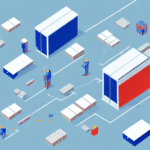Understanding Kitting and Warehouse Efficiency
Kitting involves the process of grouping individual items or components into ready-to-assemble sets and prepackaged kits to expedite assembly operations. The primary goal of kitting is to reduce assembly lead time, increase efficiency, and minimize waste. In kitting warehouses, the focus is on assembling and delivering customized kits to the final assembly line or directly to customers. Effective warehouse efficiency in kitting ensures that operations and staff are organized, enabling each team member to work effectively and fulfill orders promptly.
One of the key benefits of kitting is the reduction of inventory costs. By consolidating items into kits, it becomes easier to manage inventory levels, preventing both overstocking and understocking of individual components. Additionally, kitting can decrease the amount of space needed to store inventory, as pre-packaged kits occupy less space than separate items. According to a Inbound Logistics report, businesses can achieve significant cost savings and improved storage efficiency through effective kitting practices.
Identifying and Overcoming Bottlenecks
Identifying Bottlenecks in Your Kitting Warehouse
The first step in optimizing your kitting warehouse is to identify bottlenecks—areas that slow down operations. These bottlenecks can stem from inadequate staffing, inefficient workflows, or poor inventory management. Conducting a workflow analysis or utilizing tools like value stream mapping can help pinpoint operational inefficiencies. Additionally, analyzing data on inventory levels, order processing times, and employee productivity can highlight specific areas that require improvement.
Overcoming Common Challenges
Kitting warehouses often face challenges such as managing diverse kit types and ensuring up-to-date inventory. Implementing barcode scanning systems and real-time inventory tracking can address these issues. Engaging staff in problem-solving and continuously reviewing workflows can also help in mitigating common obstacles. Collaboration and effective communication between staff and management are essential for overcoming these challenges and enhancing overall efficiency.
Streamlining Workflow and Leveraging Technology
Streamlining Your Workflow
Optimizing workflow is crucial for enhancing efficiency in kitting warehouses. This involves standardizing procedures, minimizing handling, automating repetitive tasks, and reducing unnecessary movement. By mapping out existing processes, you can identify areas for improvement and retrain staff to adopt more efficient methods. Grouping similar tasks and organizing workstations strategically can further reduce time spent on transitions and increase productivity.
Leveraging Technology
Technology plays a pivotal role in optimizing kitting warehouse operations. Implementing a digital Warehouse Management System (WMS) can provide real-time visibility into inventory levels, order statuses, and employee productivity. Automation systems, such as Automated Storage and Retrieval Systems (ASRS) and RFID tracking, can significantly enhance accuracy and speed in order fulfillment. According to a Supply Chain Digital survey, businesses that adopt advanced technologies in their warehouses report up to a 20% increase in operational efficiency.
Quality Control and Performance Measurement
Minimizing Errors and Improving Quality Control
Effective quality control is essential to prevent errors that can lead to lost productivity and dissatisfied customers. Implementing multiple verification steps, such as having different staff members check orders before shipping, can reduce the likelihood of mistakes. Utilizing scanning systems for inventory management and order tracking further enhances accuracy. Establishing standardized quality control procedures ensures consistency and reliability in the fulfillment process.
Measuring and Analyzing Performance Metrics
Tracking key performance metrics provides valuable insights into the efficiency of your kitting warehouse operations. Metrics such as inventory turnover, order accuracy, order-to-delivery time, and labor productivity help identify areas for improvement. Utilizing data analytics tools can facilitate data-driven decision-making, enabling continuous optimization of processes. Regularly reviewing performance data ensures that your warehouse operations remain aligned with business objectives and industry standards.
Sustainable Practices and Staff Training
Sustainable Practices for an Eco-Friendly Warehouse
Incorporating sustainability into warehouse operations not only benefits the environment but also enhances operational efficiency. Implementing waste reduction strategies, such as recycling and minimizing packaging materials, can lower costs and reduce environmental impact. Utilizing energy-efficient lighting and machinery, as well as sourcing green energy, contributes to a more sustainable warehouse. According to a GreenBiz article, sustainable practices can lead to long-term cost savings and improved corporate reputation.
Best Practices for Training Staff
Investing in staff training is crucial for maintaining an efficient kitting warehouse. Regular training programs ensure that employees are proficient in using warehouse management systems, handling equipment safely, and adhering to standardized procedures. Training on lean principles and continuous improvement methodologies empowers employees to identify and eliminate inefficiencies. Providing ongoing education and development opportunities fosters a culture of excellence and drives operational performance.
Future Trends in Kitting Warehousing
The landscape of kitting warehouses is continually evolving, driven by technological advancements and changing market demands. Future trends include the integration of Artificial Intelligence (AI) and Machine Learning (ML) in warehouse management systems to predict demand patterns and optimize inventory levels. The use of drones for inventory management and the deployment of Internet of Things (IoT) sensors for real-time tracking are set to revolutionize warehouse operations. Staying abreast of these trends enables businesses to adopt innovative solutions, maintain competitiveness, and achieve higher efficiency levels.
Conclusion
Optimizing your kitting warehouse for maximum efficiency is an ongoing endeavor that requires meticulous attention to detail, a commitment to continuous improvement, and adaptability to emerging trends. By understanding the fundamentals of kitting, identifying and addressing bottlenecks, streamlining workflows, leveraging advanced technologies, ensuring quality control, implementing sustainable practices, and investing in staff training, you can significantly enhance the efficiency of your warehouse operations. Embracing these strategies will not only improve operational performance but also provide a competitive edge in the dynamic landscape of supply chain management.






















